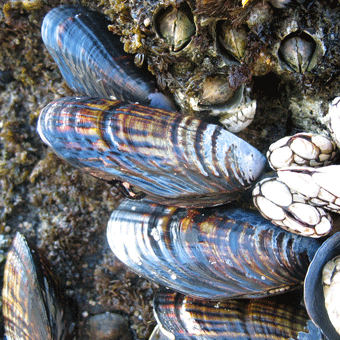
Attached to the rocks and to each other, California mussels offer different kinds of habitats.
California mussels produce a liquid adhesive from a gland opposite the hinge; a special grove in the mussel’s foot directs the adhesive to connect to something hard. Exposure to the seawater makes the adhesive solidify as the foot is retracted, and the mussel tightens down the line to keep firmly in place.
Attached together, the mussels form beds at a characteristic level in the intertidal. Many other animals and some seaweeds attach to the mussel shells, including barnacles, calcareous tubeworms, and sea palms.
Since the mussels are bluntly pointed on the bottom, there’s some space between them even when the sides are packed together. The spaces under and between the mussels are a haven for many animals, protecting them from crashing surf at high tides and drying sun at low tides, as well as protecting them from many predators.
Take care to not dislodge the mussels and expose the life beneath.
Mussels can grow so large they wedge themselves off the rock, leaving a gap in the mussel bed—too, surf-borne rocks or logs and low-tide borne people sometimes remove sections of mussel beds. It takes many years for a healthy mussel bed to become reestablished in a bald patch.
